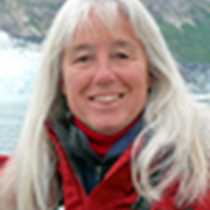Cabo San Lucas/Gorda Banks
It was a calm passage of 160 miles in the open Pacific Ocean from Magdalena Bay, across the Tropic of Cancer, to Land's End at the tip of the Baja Peninsula. A light breeze and clear skies greeted the early risers as they watched the morning sky turn orange and the sun glisten over the ridgeline. The granitic spine of the Baja Peninsula is exposed at this point.
Guests were offered several choices for activities in the bustling town of Cabo San Lucas. These included snorkeling, bird watching, and shopping.
A select group of guests strolled with Naturalist Lee Moll and found two endemic species of birds - the gray thrasher and the Xantus hummingbird - among many other interesting species. The hooded oriole, in its orangey-gold and black cloak, was a sharp contrast to the miniature yellow-headed verdin, flitting about in the native habitat. The cactus wren, ash-throated flycatcher, northern mockingbird, Costa's hummingbird, and house finches were an added bonus to this successful birding excursion.
A group of snorkelers visited a lovely beach to enjoy the warm tropical waters and explore the beautiful underwater world. The Undersea Specialist, Carlos Navarro, saw and filmed one of his favorite fish, the convict tang. Parrotfish, grunts, Mexican goatfish, guineafowl puffers, and Cortez rainbow wrasses were other colorful inhabitants of the rocky reef. Corals and a variety of invertebrates were also spotted at this location.
Shoppers had a plethora of stores to investigate, led by Adrian Cerda. A map of the town highlighted places to purchase tourist trinkets, t-shirts, cigars, tequila, silver jewelry from Taxco, and colorful ceramics.
As the Sea Lion pulled away from the dock, margaritas were served on the bow and we nosed in near the towering light-colored granitic formations, including the famous sea arch, at Land's End. On nearby rocks we noticed magnificent frigatebirds, California sea lions, brown boobies, and brown pelicans. Although this in not a nesting site, some of the male frigatebirds sported inflated throat pouches and were surrounded by adult females.
After lunch, guests were back out on the deck scanning the horizon searching for other marine life near the Gorda Banks, which is an underwater seamount that humpback whales are known to frequent during the winter. Several surface-active groups of this endangered species entertained us with breaches, flukes, and males jousting for the attention of a female. In-between the whales, common dolphins came and rode the bow wave of the Sea Lion and devil rays did flips. At one point, we lowered the ship's hydrophone (an underwater microphone) to listen to the sounds of the whales and dolphins. An exciting bird sighting was that of a red-billed tropicbird that flew overhead.
The sun set behind the now-distant rocks at the tip of the Baja Peninsula and we cruised north toward our adventures in the Sea of Cortez.
It was a calm passage of 160 miles in the open Pacific Ocean from Magdalena Bay, across the Tropic of Cancer, to Land's End at the tip of the Baja Peninsula. A light breeze and clear skies greeted the early risers as they watched the morning sky turn orange and the sun glisten over the ridgeline. The granitic spine of the Baja Peninsula is exposed at this point.
Guests were offered several choices for activities in the bustling town of Cabo San Lucas. These included snorkeling, bird watching, and shopping.
A select group of guests strolled with Naturalist Lee Moll and found two endemic species of birds - the gray thrasher and the Xantus hummingbird - among many other interesting species. The hooded oriole, in its orangey-gold and black cloak, was a sharp contrast to the miniature yellow-headed verdin, flitting about in the native habitat. The cactus wren, ash-throated flycatcher, northern mockingbird, Costa's hummingbird, and house finches were an added bonus to this successful birding excursion.
A group of snorkelers visited a lovely beach to enjoy the warm tropical waters and explore the beautiful underwater world. The Undersea Specialist, Carlos Navarro, saw and filmed one of his favorite fish, the convict tang. Parrotfish, grunts, Mexican goatfish, guineafowl puffers, and Cortez rainbow wrasses were other colorful inhabitants of the rocky reef. Corals and a variety of invertebrates were also spotted at this location.
Shoppers had a plethora of stores to investigate, led by Adrian Cerda. A map of the town highlighted places to purchase tourist trinkets, t-shirts, cigars, tequila, silver jewelry from Taxco, and colorful ceramics.
As the Sea Lion pulled away from the dock, margaritas were served on the bow and we nosed in near the towering light-colored granitic formations, including the famous sea arch, at Land's End. On nearby rocks we noticed magnificent frigatebirds, California sea lions, brown boobies, and brown pelicans. Although this in not a nesting site, some of the male frigatebirds sported inflated throat pouches and were surrounded by adult females.
After lunch, guests were back out on the deck scanning the horizon searching for other marine life near the Gorda Banks, which is an underwater seamount that humpback whales are known to frequent during the winter. Several surface-active groups of this endangered species entertained us with breaches, flukes, and males jousting for the attention of a female. In-between the whales, common dolphins came and rode the bow wave of the Sea Lion and devil rays did flips. At one point, we lowered the ship's hydrophone (an underwater microphone) to listen to the sounds of the whales and dolphins. An exciting bird sighting was that of a red-billed tropicbird that flew overhead.
The sun set behind the now-distant rocks at the tip of the Baja Peninsula and we cruised north toward our adventures in the Sea of Cortez.




